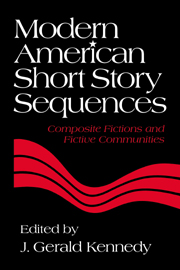Book contents
- Frontmatter
- Contents
- Contributors
- Introduction: The American Short Story Sequence – Definitions and Implications
- Henry James's Incipient Poetics of the Short Story Sequence: The Finer Grain (1910)
- Toomer's Cane as Narrative Sequence
- Hemingway's In Our Time: The Biography of a Book
- Wright Writing Reading: Narrative Strategies in Uncle Tom's Children
- The African-American Voice in Faulkner's Go Down, Moses
- Meditations on Nonpresence: Re-visioning the Short Story in Eudora Welty's The Wide Net
- Nine Stories: J. D. Salinger's Linked Mysteries
- Cheever's Shady Hill: A Suburban Sequence
- John Updike's Olinger Stories: New Light Among the Shadows
- Louise Erdrich's Love Medicine: Narrative Communities and the Short Story Sequence
- From Anderson's Winesburg to Carver's Cathedral: The Short Story Sequence and the Semblance of Community
- Index
Louise Erdrich's Love Medicine: Narrative Communities and the Short Story Sequence
Published online by Cambridge University Press: 29 September 2009
- Frontmatter
- Contents
- Contributors
- Introduction: The American Short Story Sequence – Definitions and Implications
- Henry James's Incipient Poetics of the Short Story Sequence: The Finer Grain (1910)
- Toomer's Cane as Narrative Sequence
- Hemingway's In Our Time: The Biography of a Book
- Wright Writing Reading: Narrative Strategies in Uncle Tom's Children
- The African-American Voice in Faulkner's Go Down, Moses
- Meditations on Nonpresence: Re-visioning the Short Story in Eudora Welty's The Wide Net
- Nine Stories: J. D. Salinger's Linked Mysteries
- Cheever's Shady Hill: A Suburban Sequence
- John Updike's Olinger Stories: New Light Among the Shadows
- Louise Erdrich's Love Medicine: Narrative Communities and the Short Story Sequence
- From Anderson's Winesburg to Carver's Cathedral: The Short Story Sequence and the Semblance of Community
- Index
Summary
Louise Erdrich's Love Medicine (1984) is most often classified as a novel. In fact, if we have any doubts about its genre, the title page informs us: “Love Medicine”. A Novel by Louise Erdrich.” When asked what they thought about the fact that some reviewers of the “novel” insisted on labeling it a “collection of short stories,” Erdrich and her husband-collaborator Michael Dorris were not particularly interested in the topic. “It's a novel in that it all moves toward some sort of resolution,” explained Erdrich. “It has a large vision that no one of the stories approaches,” added Dorris. In addition, even though half of the fourteen chapters of the first edition had been published previously as short stories in literary journals or popular magazines, Erdrich and Dorris insisted that they had adapted these individual stories significantly in order to create, extend, or enhance thematic, structural, and other literary connections. Erdrich, who describes herself as “a person who thought in terms of stories and poems and short things,” credits Dorris's influence for how the “book became a novel.” “By the time readers get half way through the book,” noted Dorris, “it should be clear to them that this is not an unrelated, or even a related, set of short stories, but parts of a larger scheme” (Wong, 212). Length, an expansive vision, and some sense of unity seem to inform their notion of what constitutes a novel.
It was surprising, then, to find little difference between the chapters of Love Medicine and the short stories published earlier.
- Type
- Chapter
- Information
- Modern American Short Story SequencesComposite Fictions and Fictive Communities, pp. 170 - 193Publisher: Cambridge University PressPrint publication year: 1995
- 1
- Cited by



